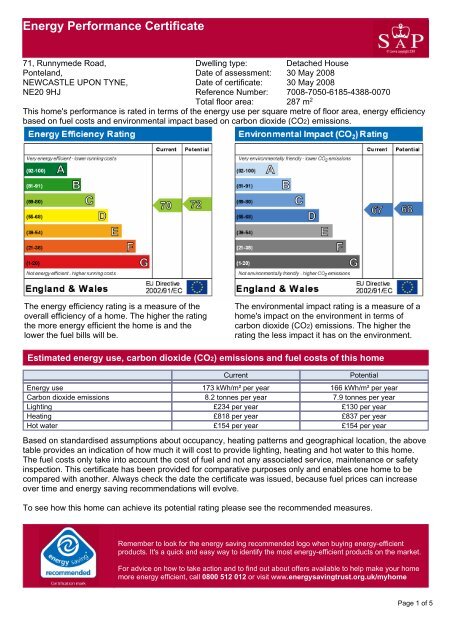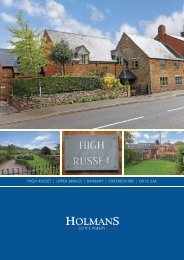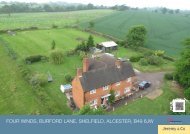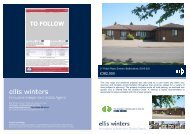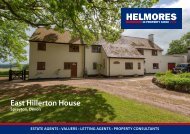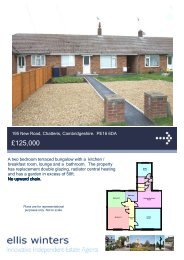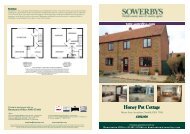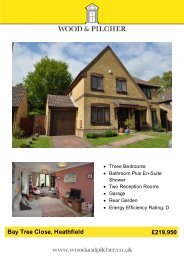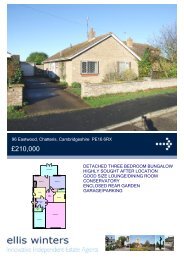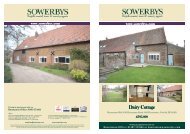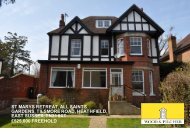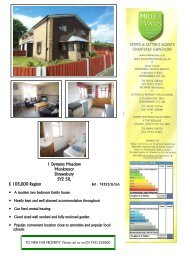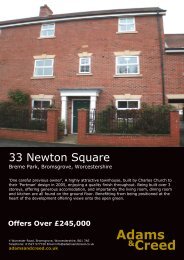Energy Performance Certificate
Energy Performance Certificate
Energy Performance Certificate
You also want an ePaper? Increase the reach of your titles
YUMPU automatically turns print PDFs into web optimized ePapers that Google loves.
<strong>Energy</strong> <strong>Performance</strong> <strong>Certificate</strong><br />
71, Runnymede Road,<br />
Ponteland,<br />
NEWCASTLE UPON TYNE,<br />
NE20 9HJ<br />
Dwelling type: Detached House<br />
Date of assessment: 30 May 2008<br />
Date of certificate: 30 May 2008<br />
Reference Number: 7008-7050-6185-4388-0070<br />
Total floor area: 287 m 2<br />
This home's performance is rated in terms of the energy use per square metre of floor area, energy efficiency<br />
based on fuel costs and environmental impact based on carbon dioxide (CO2) emissions.<br />
The energy efficiency rating is a measure of the<br />
overall efficiency of a home. The higher the rating<br />
the more energy efficient the home is and the<br />
lower the fuel bills will be.<br />
The environmental impact rating is a measure of a<br />
home's impact on the environment in terms of<br />
carbon dioxide (CO2) emissions. The higher the<br />
rating the less impact it has on the environment.<br />
Estimated energy use, carbon dioxide (CO2) emissions and fuel costs of this home<br />
Current Potential<br />
<strong>Energy</strong> use 173 kWh/m² per year 166 kWh/m² per year<br />
Carbon dioxide emissions 8.2 tonnes per year 7.9 tonnes per year<br />
Lighting £234 per year £130 per year<br />
Heating £818 per year £837 per year<br />
Hot water £154 per year £154 per year<br />
Based on standardised assumptions about occupancy, heating patterns and geographical location, the above<br />
table provides an indication of how much it will cost to provide lighting, heating and hot water to this home.<br />
The fuel costs only take into account the cost of fuel and not any associated service, maintenance or safety<br />
inspection. This certificate has been provided for comparative purposes only and enables one home to be<br />
compared with another. Always check the date the certificate was issued, because fuel prices can increase<br />
over time and energy saving recommendations will evolve.<br />
To see how this home can achieve its potential rating please see the recommended measures.<br />
Remember to look for the energy saving recommended logo when buying energy-efficient<br />
products. It's a quick and easy way to identify the most energy-efficient products on the market.<br />
For advice on how to take action and to find out about offers available to help make your home<br />
more energy efficient, call 0800 512 012 or visit www.energysavingtrust.org.uk/myhome<br />
Page 1 of 5
71, Runnymede Road, Ponteland, NEWCASTLE UPON TYNE, NE20 9HJ<br />
30 May 2008 RRN: 7008-7050-6185-4388-0070<br />
<strong>Energy</strong> <strong>Performance</strong> <strong>Certificate</strong><br />
About this document<br />
The <strong>Energy</strong> <strong>Performance</strong> <strong>Certificate</strong> for this dwelling was produced following an energy assessment<br />
undertaken by a qualified assessor, accredited by the RICS, to a scheme authorised by the<br />
Government. This certificate was produced using the RdSAP 2005 assessment methodology and has been<br />
produced under the <strong>Energy</strong> <strong>Performance</strong> of Buildings (<strong>Certificate</strong>s and Inspections) (England and Wales)<br />
Regulations 2007. A copy of the certificate has been lodged on a national register.<br />
Assessor's accreditation number: RICS200146<br />
Assessor's name: Philip Wragg<br />
Company name/trading name: Northern <strong>Energy</strong> Assessors<br />
Address: Victoria House<br />
Hampshire Court,Newcastle-upon-Tyne,NE4 7YL<br />
Phone number: 01912463816<br />
Fax number: 01912869238<br />
E-mail address: philip.wragg@northernenergyassessors.co.uk<br />
Related party disclosure: none<br />
If you have a complaint or wish to confirm that the certificate is genuine<br />
Details of the assessor and the relevant accreditation scheme are on the certificate. You can get contact<br />
details of the accreditation scheme from our website at http://www.rics.org together with details of their<br />
procedures for confirming authenticity of a certificate and for making a complaint.<br />
About the bulding's performance ratings<br />
The ratings on the certificate provide a measure of the building's overall energy efficiency and its<br />
environmental impact, calculated in accordance with a national methodology that takes into account factors<br />
such as insulation, heating and hot water systems, ventilation and fuels used. The average energy efficiency<br />
rating for a dwelling in England and Wales is band E (rating 46).<br />
Not all buildings are used in the same way, so energy ratings use 'standard occupancy' assumptions which<br />
may be different from the specific way you use your building. Different methods of calculation are used for<br />
homes and for other buildings. Details can be found at www.communities.gov.uk/epbd.<br />
Buildings that are more energy efficient use less energy, save money and help protect the environment. A<br />
building with a rating of 100 would cost almost nothing to heat and light and would cause almost no carbon<br />
emissions. The potential ratings in the certificate describe how close this building could get to 100 if all the<br />
cost effective recommended improvements were implemented.<br />
About the impact of buildings on the environment<br />
One of the biggest contributors to global warming is carbon dioxide. The way we use energy in buildings<br />
causes emissions of carbon. The energy we use for heating, lighting and power in homes produces over a<br />
quarter of the UK's carbon dioxide emissions and other buildings produce a further one-sixth.<br />
The average household causes about 6 tonnes of carbon dioxide every year. Adopting the recommendations<br />
in this report can reduce emissions and protect the environment. You could reduce emissions even more by<br />
switching to renewable energy sources. In addition there are many simple every day measures that will save<br />
money, improve comfort and reduce the impact on the environment, such as:<br />
Check that your heating system thermostat is not set too high (in a home, 21°C in the living room is<br />
suggested) and use the timer to ensure you only heat the building when necessary.<br />
Make sure your hot water is not too hot - a cylinder thermostat need not normally be higher than 60°C.<br />
Turn off lights when not needed and do not leave appliances on standby. Remember not to leave<br />
chargers (e.g. for mobile phones) turned on when you are not using them.<br />
Visit the Government's website at www.communities.gov.uk/epbd to:<br />
Find how to confirm the authenticity of an energy performance certificate<br />
Find how to make a complaint about a certificate or the assessor who produced it<br />
Learn more about the national register where this certificate has been lodged<br />
Learn more about energy efficiency and reducing energy consumption<br />
Page 2 of 5
Recommended measures to improve this home's energy performance<br />
71, Runnymede Road,<br />
Ponteland,<br />
NEWCASTLE UPON TYNE,<br />
NE20 9HJ<br />
Date of certificate: 30 May 2008<br />
Reference Number: 7008-7050-6185-4388-0070<br />
Summary of this home's energy performance related features<br />
The following is an assessment of the key individual elements that have an impact on this home's<br />
performance rating. Each element is assessed against the following scale: Very poor / Poor / Average /<br />
Good / Very good.<br />
Element Description<br />
Walls<br />
Roof<br />
Floor<br />
Windows<br />
Main Heating<br />
Main Heating Controls<br />
Secondary Heating<br />
Water Heating<br />
Lighting<br />
Cavity wall, filled cavity<br />
Cavity wall, as built, insulated (assumed)<br />
Pitched, 100mm loft insulation<br />
Solid, no insulation (assumed)<br />
Fully double glazed<br />
Boiler and radiators, mains gas<br />
Programmer, room thermostat and TRVs<br />
Room heaters, mains gas<br />
From main system<br />
Low energy lighting in 20% of fixed outlets<br />
Current performance<br />
<strong>Energy</strong> Efficiency Environmental<br />
Good<br />
Good<br />
Average<br />
-<br />
Average<br />
Good<br />
Average<br />
-<br />
Good<br />
Good<br />
Good<br />
Average<br />
-<br />
Average<br />
Very Good<br />
Average<br />
-<br />
Very Good<br />
Current energy efficiency rating C 70<br />
Current environmental impact (CO2) rating D 67<br />
Poor<br />
Poor<br />
Page 3 of 5
71, Runnymede Road, Ponteland, NEWCASTLE UPON TYNE, NE20 9HJ<br />
30 May 2008 RRN: 7008-7050-6185-4388-0070<br />
Recommendations<br />
Recommendations<br />
The measures below are cost effective. The performance ratings after improvement listed below are<br />
cumulative, that is they assume the improvements have been installed in the order that they appear in the<br />
table.<br />
Lower cost measures (up to £500)<br />
1 Low <strong>Energy</strong> Lights<br />
Higher cost measures (over £500)<br />
Typical savings<br />
per year<br />
£86<br />
Sub-total £86<br />
<strong>Performance</strong> rating after improvements<br />
<strong>Energy</strong> Efficiency Environmental<br />
Total £86<br />
Current energy efficiency rating C 72<br />
Current environmental impact (CO2) rating D 68<br />
Further measures to achieve even higher standards<br />
The further measures listed below should be considered in addition to those already specified if aiming for<br />
the highest possible standards for this home.<br />
2 Photovoltaics<br />
Enhanced energy efficiency rating C 75<br />
Enhanced environmental impact (CO2) rating C 72<br />
Improvements to the energy efficiency and environmental impact ratings will usually be in step with each<br />
other. However, they can sometimes diverge because reduced energy costs are not always accompanied by<br />
a reduction in carbon dioxide (CO2) emissions<br />
£149<br />
C 72<br />
C 75<br />
D 68<br />
C 72<br />
Page 4 of 5
71, Runnymede Road, Ponteland, NEWCASTLE UPON TYNE, NE20 9HJ<br />
30 May 2008 RRN: 7008-7050-6185-4388-0070<br />
1 For information on competent persons schemes enter "existing competent person schemes" into an internet search engine or<br />
contact your local <strong>Energy</strong> Saving Trust advice centre on 0800 512 012.<br />
Recommendations<br />
About the cost effective measures to improve this home's performance ratings<br />
Lower cost measures (typically up to £500 each)<br />
These measures are relatively inexpensive to install and are worth tackling first. Some of them may be<br />
installed as DIY projects. DIY is not always straightforward, and sometimes there are health and safety risks,<br />
so take advice before carrying out DIY improvements.<br />
1 Low <strong>Energy</strong> Lights<br />
Replacement of traditional light bulbs with energy saving recommended ones will reduce lighting costs over the<br />
lifetime of the bulb, and they last up to 12 times longer than ordinary light bulbs.<br />
Higher cost measures (typically over £500 each)<br />
About the further measures to achieve even higher standards<br />
Further measures that could deliver even higher standards for this home.<br />
2 Photovoltaics<br />
A solar photovoltaic (PV) system is one which converts light directly into electricity via panels placed on the roof<br />
with no waste and no emissions. This electricity is used throughout the home in the same way as the electricity<br />
purchased from an energy supplier. The Solar Trade Association has up-to-date information on local installers<br />
and any grant that may be available. Building Regulations apply to this work, so your local authority building<br />
control department should be informed, unless the installer is registered with a competent persons scheme{1},<br />
and can therefore self-certify the work for Building Regulation compliance.<br />
Page 5 of 5


